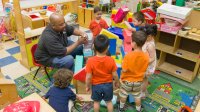Helping Children With Special Needs Transition to Kindergarten
Teacher-tested tips for preparing children in early childhood special education for kindergarten.
Your content has been saved!
Go to My Saved Content.The transition from a small early childhood special education (ECSE) class to kindergarten can be exciting yet overwhelming for students with disabilities and their families. Students face a lot of adjustments: a longer school day, a larger class size, new classmates, and new teachers.
For the past five years, I’ve worked with dozens of children and their families to help them adjust to this new environment. I’ve learned that the following strategies facilitate a smooth transition, decrease students’ anxiety, and prepare them for success.
Using Social Stories
Social stories were developed for higher-functioning students with autism; however, they can be helpful for students with other disabilities as well. According to Carol Gray, the creator of social stories, the goal of a social story is to “share accurate information using a content, format, and voice that is descriptive, meaningful, and physically, socially, and emotionally safe.”
Social stories should include descriptive sentences (“Next year, I will be in a new classroom with a new teacher and new rules”), perspective sentences (“I may feel scared or nervous in my new classroom”), directive sentences (“I will work on learning the new rules and listening to my new teacher”), and affirmative sentences (“My new teacher will be happy when I follow the new rules”). For preschool-age children, pictures also can make the story more comprehensible.
The following is a social story I have used with my students.
Transition IEP Meeting
Although there are currently no laws requiring schools to have a transitional individualized education program (IEP) meeting when a student exits an ECSE program, it can be helpful for the kindergarten staff and families to hold such a meeting. These meetings allow the ECSE and kindergarten special education staff to collaboratively create a transition plan and IEP that will support and meet the needs of the student. Depending on the situation and the school’s setup, it may also be beneficial to have a general education kindergarten teacher attend the meeting in order to answer the family’s questions, discuss accommodations and modifications, and make a plan for inclusion.
Observations
The student should have the opportunity to visit their new classroom(s) and may benefit from participating in story time or snack time there. This will also allow staff to see what additional supports the student may need to be successful in their new environment (such as noise-canceling headphones in a large group setting or a designated spot to sit on the carpet).
Additionally, the kindergarten special education teacher and/or teaching assistants may benefit from observing the student in the current ECSE classroom. Observation will show them how the student communicates, interacts with staff and peers, participates in group activities, and demonstrates self-help skills.
Photo Book
Another transition support that can help students is a teacher-created book with photos of the student’s new special education teacher and teaching assistants, kindergarten teacher, classrooms, lunchroom, etc. Families can read this book with the child over the summer. This is different from a social story in that it does not include feelings, expected behaviors, or perspective taking.
Orientation Considerations
At the beginning of the school year, many school districts host a kindergarten orientation, when students and their families meet the teacher, drop off school supplies, and learn the policies, procedures, and expectations for kindergarten. These orientations usually have a group of four to five students attending at a time. For some students with disabilities, an individual orientation may be more appropriate and/or less overwhelming. The family may also feel more comfortable asking questions and sharing relevant information about the student and their disability.
Modifications
Lastly, I recommend that ECSE teachers observe both the general education and special education kindergarten classrooms. Some things to consider while observing the new environments:
- What visuals, language, and expectations can I introduce so my students have a smooth transition?
- What activities, materials, or expectations might need to be adapted or modified for my students once they’re in kindergarten?
- What self-help or functional skills do I need to work on with my students to promote independence and confidence in kindergarten?
The end of the year is always bittersweet for me: I’m so excited for my students to begin the next chapter in their lives as kindergarteners, but at the same time, I’m sad to say goodbye to students I’ve had the joy and privilege of working with for two to three years. Each year, I utilize all of these tips to individually support my students as they transition to kindergarten.
